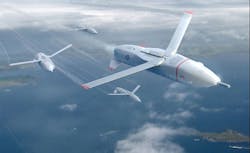Composite Engineering to develop enabling technologies for low-cost unmanned attack aircraft
Officials of the Air Force Research Laboratory at Wright-Patterson Air Force Base, Ohio, announced a $40.8 million cost-share contract Friday to CEI for the Low-Cost Attritable Strike Unmanned Aerial System (UAS) Demonstration project. CEI is part of Kratos Defense & Security Solutions Inc.
The Air Force is asking CEI experts to develop enabling technologies for affordable UAVs able to carry out long-range and high-speed attacks that are of sufficiently low cost that loss of these aircraft in battle could be tolerated, researchers say.
CEI also is participating in the Gremlins program of the U.S. Defense Advanced Research Projects Agency (DARPA), which seeks to use C-130 aircraft to launch drone swarms of networked and cooperating unmanned aircraft for electronic attack and reconnaissance missions from standoff ranges. DARPA Gremlins relies on relatively inexpensive UAVs in volley quantities to saturate enemy defenses.
Related: Air Force ready to approach industry for enabling technologies in affordable attack drones
On the Low-Cost Attritable Strike UAS Demonstration project CEI experts will design, develop, assemble, and test a technical baseline for a high-speed, long-range, low-cost, limited-life strike UAV, identify key enabling technologies for future low-cost aircraft demonstrations, and provide a test drone for future capability and technology demonstrations.
Tight defense budgets and many kinds of military threats throughout the world are encouraging the Air Force to make dramatic reductions in the costs of attack UAVs to bring mass to the engagement, and increase defensive costs to potential adversaries, officials say.
Researchers want to trade the relatively high costs of UAV performance, design life, reliability, and maintainability for low-cost attritable aircraft intended for reuse with limited life and number of sorties.
The goal of this program is to establish a benchmark concluding in a flight demonstration that will test the bounds of what can be accomplished in a short time to establish a baseline system cost against a notional set of strike vehicle requirements, researchers say.
Related: Race is on to find technologies to counter low-cost unmanned aircraft
Air Force researchers want to develop UAV concepts that offer dramatic cost reductions to bring many unmanned aircraft to future engagements. The key will be to drive down the costs of unmanned strike aircraft, and reduce the time it takes to develop them.
UAV performance, design life, reliability, and maintainability drive the cost of today’s systems, and need to be traded to cut costs and development time, researchers say -- even if that means developing attack UAVs that are not expected to survive combat.
Affordability could be attained, in part, by relaxing traditional Air Force acquisition policy and standards, researchers say. Relaxing traditional requirements could enable new and innovative design approaches, application of commercial technologies, and new low-cost manufacturing and assembly processes.
Efficient manufacturing technologies and nontraditional industry processes will be key to achieving the low cost goals of the attritable aircraft vision. This vision includes on-demand system manufacturing by leveraging open systems architecture, commercial off-the-shelf (COTS) components, and distributed manufacturing.
Related: Low-cost precision strike capability tested on drones
On this contract the government share is $7.3 million and CEI's share is $33.5 million. CEI will do the work in Sacramento, Calif., and should be finished by April 2019.
For more information contact (CEI) Unmanned Systems Division online at www.kratosusd.com, or the Air Force Research Laboratory at www.wpafb.af.mil/AFRL.
